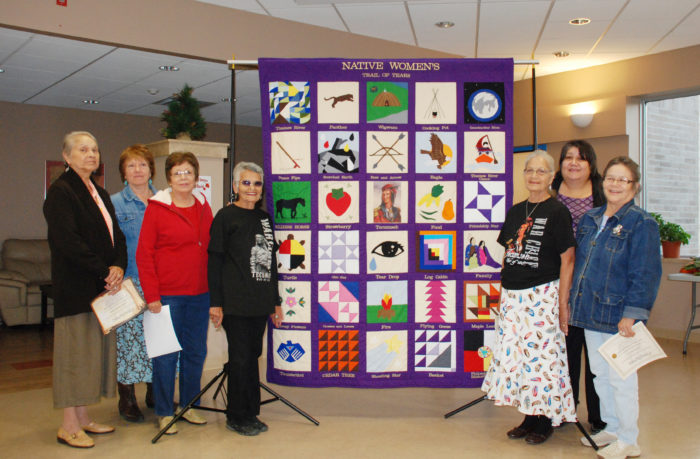Native Women’s Trail of Tears
Barn Quilt Trail We thank the Longwood’s Barn Quilt Trail for the invitation to tell the story of First Nation women and families during the War of 1812. Drawing on traditional knowledge, quilters representing Anishinaabe, Haudenosaunee and Lenape nations, have created 31 beautiful quilt block designs to capture the spirit, courage and resilience of women facing incredible dangers and uncertain futures at the turn of the 19th century. See the designs copied to large 8 x8 wooden panels.
We thank the Longwood’s Barn Quilt Trail for the invitation to tell the story of First Nation women and families during the War of 1812. Drawing on traditional knowledge, quilters representing Anishinaabe, Haudenosaunee and Lenape nations, have created 31 beautiful quilt block designs to capture the spirit, courage and resilience of women facing incredible dangers and uncertain futures at the turn of the 19th century. See the designs copied to large 8 x8 wooden panels.
-
Feathersmore_vertclose
The highest honour an Anishinaabe person could receive is an eagle feather. A fallen eagle feather meant a warrior had fallen. A special ceremony has to take place in order to retrieve it.
-
Log Cabinmore_vertclose
The log cabin became a representation to many First Nation women during this era of the growing populations of immigrants encroaching on their traditional territories. Largely unchecked and encouraged by foreign governments to settle, immigrants built their homesteads in the...
-
Firemore_vertclose
At the heart of Mother Earth is fire, the heart of all creation. Just as the Earth, our mother, has within her a heart that forever provides warmth and light; we too, as a people, have at the heart of...
-
Ohio Starmore_vertclose
The events that took place in Ohio between the many nations in the Ohio Valley and the British would set the stage for Tecumseh’s call to action. Tecumseh felt the American approach to relationships with First Nations threatened his nation’s...
-
Panthermore_vertclose
It was believed Tecumseh’s name meant panther. He was named this for his ability to hunt his enemy with strength and skill just as a panther.
-
Thunderbirdmore_vertclose
This symbol is the emblem of the Chippewas of the Thames First Nation. The Thunderbird has become a universal symbol representing the Anishinaabek nations of Ontario.
-
Friendship Starmore_vertclose
A period of peace and friendship between nations occurred during the time when Great Britain needed allies in order to defeat both the French and Americans. Upper Canada was not heavily populated during this time period and each nation relied...
-
Ojibway Flowersmore_vertclose
At the Antler Rive Comm. Ctr & Senior's Complex - During the early 1800’s, beads were in circulation along the trade routes and native women began to adorn their clothing and articles with beautiful designs of plants and flowers...
-
Flying Geesemore_vertclose
A primary food for the people, women would hunt and pluck these large birds for food.
-
Maple Leafmore_vertclose
ONA gift of maple sap was the signal of the coming of spring. It is the changing colour of the maple leaf that reminds the women of the beauty and bounty of the earth and all women.
-
Basketmore_vertclose
Basket - was used to gather sap, to harvest berries and medicines, to hold utensils and store dried goods. It was an important implement to have in the daily life of a family
-
Crosses and Lossesmore_vertclose
Crosses and Losses - Throughout the Great Lakes region during the War of 1812 many First Nation men, women and children lost their lives. The Crosses and Losses quilt block reminds us of the important work this generation has to...
-
Soldiers Horsemore_vertclose
Soldiers Horse - Tecumseh was known to ride into villages on his horse in such a fashion that it would draw attention to him and his party. Once he was able to pull them into one location his speech making...
-
Three Sistersmore_vertclose
Three Sisters - To the Haudenosaunee people, corn, beans, and squash are called the "Three Sisters". Each sister did her part to strengthen the other when grown together. Their bond reminds us of the strength of women working together. ...
-
Cooking Potmore_vertclose
Cooking Pot - By the 1800's, many European goods were common household objects in First Nation camps. Cooking pots were one of these goods. It was common place to see pots stewing over open fire pits inside camps tended by...
-
Shooting Starmore_vertclose
Shooting Star - Tecumseh's name was said to mean shooting star in Shawnee. In traditional naming ceremonies, the story behind a chosen name is a foretelling of a child's destiny. Photo by Art and Soul Photography
-
Tear Dropmore_vertclose
Tear Drop - There was much despair and sadness during war time for women and families. Many tears were shed over the losses during warfare. This barn quilt is located at the Mt. Elgin Residential School Memorial Site.
-
Grandmother Moonmore_vertclose
Grandmother Moon - Considered woman's greatest teacher, the moon is where our first Grandmother's spirit sits. She looks over us every night, ensuring the rhythm and movement of the water - the life blood of Mother Earth which must flow...
-
Turtlemore_vertclose
Turtle - The turtle is one of the three original clans of the Oneida and Lenape nations. In many creation stories, the turtle plays a significant role as do women.
-
Eaglemore_vertclose
Eagle - Considered closest to Gitche Manitou, the eagle is our eldest brother. He stood up for the people when they were no longer lighting the sacred fire and offering tobacco. For this the Anishinaabe attribute the highest honour and...
-
Thames River Canoemore_vertclose
Thames River Canoe - Women were expert guides in their own right able to carry loads of equal weight as the men, lead the way through deep woods and canoe through what others would call the inhospitable terrain of the...
-
Philosophy of Biiskabiyangmore_vertclose
Philosophy of Biiskabiyang - This quilt design demonstrates the link our ancestors have through this generation to future generations. In doing this barn quilt we are ensuring our children's children benefit from a cultural inheritance that affords them the ability...
-
Deshkan Ziibiingmore_vertclose
Thames River - Referred to as Askunesippi in historical journals, spelled Deshkan Ziibiing currently, this original Ojibwe name for the river translates to Antler or Horn River. One telling of its name sake involves a great horned serpent that once...
-
Wigwammore_vertclose
Wigwam - was the shelter of the Anishinaabe family. Around it, the creation of baskets, mats and deer hide clothing took place during the winter months by the women. Within it, the women and children laughed and told the stories...
-
Familymore_vertclose
Family - is central to Anishinaabe way of life. Family connections come in so many ways. Kinship through clans provided much needed support to families in trouble or isolated and finding themselves in unfamiliar camps. Photo by Art and Soul...
-
Tecumsehmore_vertclose
Tecumseh - was a dynamic Shawnee leader during the War of 1812. Convincing when speaking, despite language barriers, he invoked hundreds of warriors from many nations to unite in defence of their way of life and traditional territories.
-
Strawberrymore_vertclose
Strawberry - in Ojibway means heart berry. It is considered a sacred food and the first food gifted to the people by the Creator to nourish and sustain life.
-
Cedar Treemore_vertclose
Cedar Tree - Cedar, one of the four sacred medicines of the Anishinaabe, protected families from disease. Not always far from the skirmishes taking place during the war, the women tended to the injured and recovered the dead. Photo By...
-
Scorched Earthmore_vertclose
Scorched Earth - Travelling mostly in small groups, the forests were easily navigated by the women as they moved from one camp to another. However, as the war ensued and settlers encroached, former trails and familiar gathering grounds were burnt...
-
Bow and Arrowsmore_vertclose
Bows and Arrows - were the main tools used for hunting and in warfare, however, as guns and artillery were introduced into the fur trade, these were replaced and changed the strategic advantage some nations had over others in the control...
